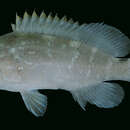Diagnostic Description
provided by Fishbase
Diagnosis: head and body dark reddish brown or greyish dorsally, usually yellowish gold ventrally; irregular white, pale greenish yellow or silvery grey blotches usually visible on the body and head and mostly arranged in vertical series; more or less distinct black maxillary streak; dark brown median fins; distal edge of anal and caudal fins, often also pectoral fins, narrowly white; pelvic fins blackish distally; pectoral fins dark reddish brown or grey; margin of spinous dorsal fin and basal part of the paired fins often golden yellow; head length 2.3-2.5 in SL; convex interorbital area; rounded preopercle, finely serrate, serrae at angle slightly enlarged; smooth subopercle and interopercle; eye diameter greater than or subequal to interorbital width in fish 10-30 cm SL, less than interorbital in fish over 40 cm SL; posterior and anterior nostrils subequal or posterior nostril slightly larger; maxilla naked, reaching to or slightly past vertical at rear edge of eye; 2-4 rows of subequal teeth on midlateral part of lower jaw (Ref. 89707).Description: body robust, its depth comprised 2.6-3.1 times in standard length; lower jaw slightly prominent; teeth of inner row depressible in both jaws; pelvic fins not reaching anus; caudal fin rounded in juveniles, truncated with rounded angles in adults; scales small, broadly imbricate, embedded in thick skin (Ref. 57293).Coloration: brown, back sometimes dark grey to reddish, belly yellowish; body and head with an irregular pattern of white spots sometimes forming diffuse vertical bars; fins dark; caudal, anal and sometimes pectoral with a tiny white edge; dorsal with a yellow-golden edge; base of pair fins often yellow-golden (Ref. 57293).
Life Cycle
provided by Fishbase
A monandric species (Ref. 55367). In Europe, sex reversal occurs when females are about 14-17 years of age and between 80 to 90 cm TL (Ref. 51466). From another study, sex change occurs at 88 cm TL and 12 years of age (Ref. 55367), between 52-77 cm TL and 7-17 years (Ref. 94520).Protogynous hermaphrodite species, reaching its first sexual maturity as female at 5 years and becoming male after 10 years (some females remain so for some more years). Spawning happens during summer.
Morphology
provided by Fishbase
Dorsal spines (total): 11; Dorsal soft rays (total): 14 - 16; Analspines: 3; Analsoft rays: 8 - 9
Trophic Strategy
provided by Fishbase
Prefers rocky bottoms (Ref. 5222). Solitary and territorial (Ref. 12382). Juveniles are found closer to shore (Ref. 48605) in rocky tidal pools (Ref. 48609). Feeds on crabs and octopi; larger individuals feed on a greater proportion of fishes, the majority of which are reef-associated species (Ref. 6842). Macro-carnivore (Ref. 126840). Feeds on fish and benthic invertebrates (Ref. 13352). Increase of nutritional requirements during the life cycle is satisfied by predating on larger prey instead of a greater number of preys (Ref. 75801).
Biology
provided by Fishbase
Adults prefer rocky bottoms (Ref. 5222), are solitary and territorial (Ref. 12382). Juveniles are found closer to shore (Ref. 48605) in rocky tidal pools (Ref. 48609). Enters brackish environments (Ref. 57293). Mainly feed on crabs and octopi; larger individuals feed on a greater proportion of fishes, the majority of which are reef-associated species (Ref. 6842). A protogynous hermaphrodite (Ref. 55367). Mature individuals form spawning aggregations (Ref. 55367). Utilized as a food fish (Ref. 171). Readily caught by anglers (Ref. 5222). Not adapted well in an aquarium (Ref. 12382).
- Recorder
- Estelita Emily Capuli
Importance
provided by Fishbase
fisheries: highly commercial; gamefish: yes; price category: very high; price reliability: reliable: based on ex-vessel price for this species
- Recorder
- Estelita Emily Capuli

